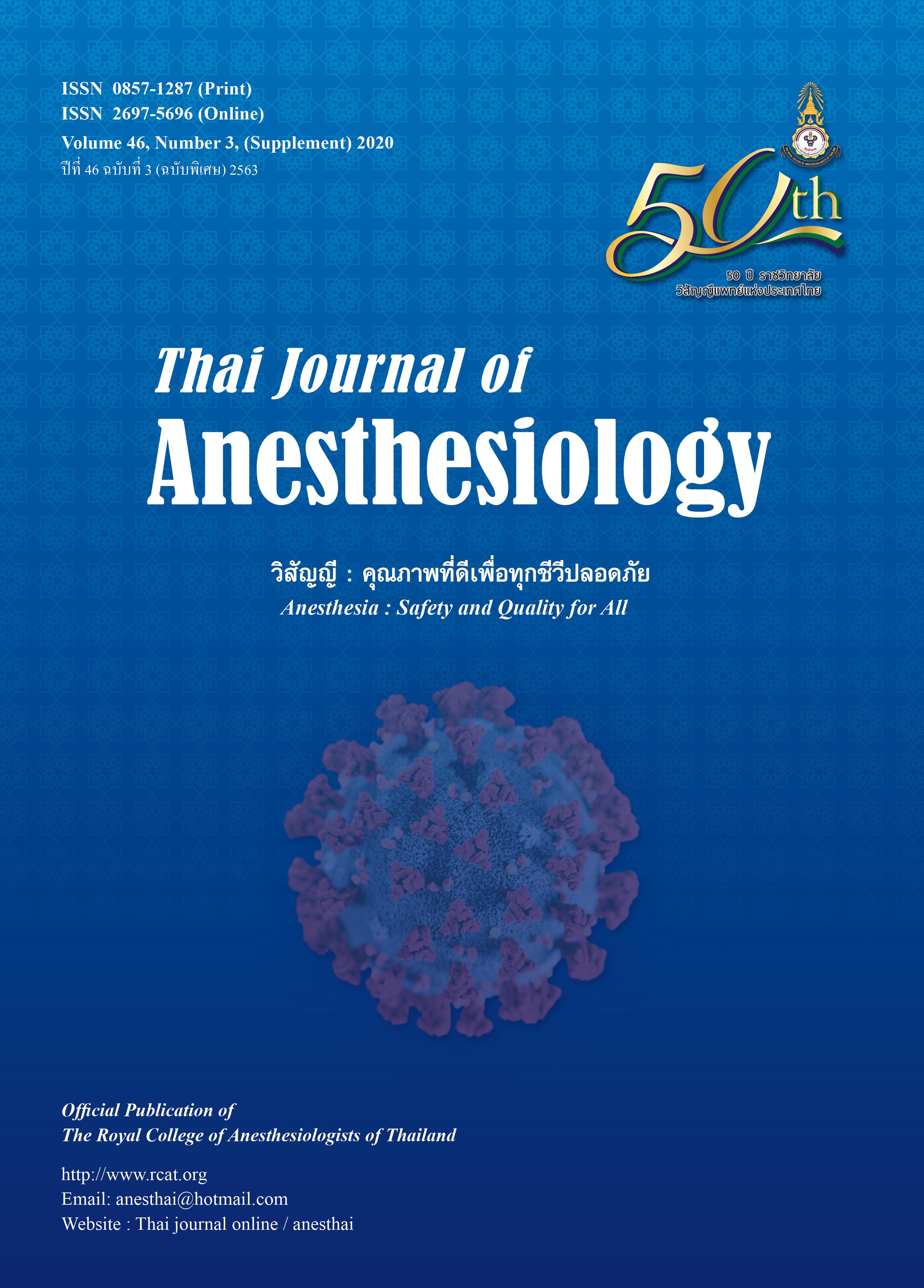Effectiveness Study of Disinfection of Microbes by Innovation Robotic UVC Radiation: Response to COVID-19 Pandemic
Main Article Content
Abstract
Background: During the COVID-19 pandemic, many
patients have been quarantined and hospitalized.
Healthcare providers thus have a high risk in contacting
the SARS-CoV-2. Measures for disinfection not involving
human works might decrease such risk and decrease
transmission rate inside the hospital.
Objectives: To study the effectiveness of innovative
robotic ultraviolet C (UVC) radiation in killing Pseudomonas
aeruginosa as a surrogate for SARS-CoV-2.
Materials and methods: The robotic UVC comprised of
12 UVC lamps (TUV 36W SLV) forming in cylinder shape
perpendicular to robotic 4 wheels base controlled direction
of movement by remote control. P. aeruginosa are
common etiology of hospital-acquired infection and
generally tolerate to UVC more than the coronaviruses.
We studied killing effect of innovative robotic UVC to these
bacteria on various surfaces including glass, plastic and
stainless-steel at 0.5-3 meters from the device.
Results: Under the same exposure time and UVC dose,
eradication of P. aeruginosa on the glass surface was the
hardest comparing to other surfaces. This robotic
innovation was effective in killing 99.9% of P. aeruginosa
on the plastic and the stainless-steel surfaces within 3
minutes at the distance of 3 meters from the device. When
the exposure time was increased to 10 minutes, 99.9% of
the microbes on all surfaces in this study were killed.
Conclusion: Robotic UVC radiation was effective in killing
P. aeruginosa, which is more tolerate to UVC than the
coronaviruses. Implementing UVC radiation might help
decrease risk of hospital transmission in operating theater,
intensive care unit or cohort ward.
Article Details
References
patients with pneumonia in China, 2019. N Engl J Med
2020;382:727-33.
2. Li Q, Guan X, Wu P, et al. Early transmission dynamics in
Wuhan, China, of Novel Coronavirus-infected pneumonia.
N Engl J Med 2020;382:1199-207.
3. Lu R, Zhao X, Li J, et al. Genomic characterisation and
epidemiology of 2019 novel coronavirus: implications for
virus origins and receptor binding. Lancet 2020;395:565-74.
4. Thailand responding to the novel coronavirus: World Health
Organization; 2020 [internet].[cited 2020 May 21]. Available
from: https://www.who.int/thailand/news/detail/13-01-2020-
thailand-responding-to-the-novel-coronavirus.
5. Novel Coronavirus(2019-nCoV) situation report–12: World
Health Organization; 2020 [internet].[cited 2020 May 21].
Available from: https://www.who.int/docs/default-source/
coronaviruse/situation-reports/20200201-sitrep-12-ncov.
pdf?sfvrsn=273c5d35_2.
6. Statement on the second meeting of the International Health
Regulations (2005) emergency committee regarding the
outbreak of novel coronavirus (2019-nCoV): World Health
Organization; 2020 [internet].[cited 2020 May 21]. Available
from: https://www.who.int/news-room/detail/30-01-2020-
statement-on-the-second-meeting-of-the-internationalhealth-
regulations-(2005)-emergency-committee-regardingthe-
outbreak-of-novel-coronavirus-(2019-ncov).
7. Kim DK, Kang DH. UVC LED irradiation effectively inactivates
aerosolized viruses, bacteria, and fungi in a chamber-type
air disinfection system. Appl Environ Microbiol 2018;84.
DOI: 10.1128/AEM.00944-18
8. Ye Y, Chang PH, Hartert J, Wigginton KR. Reactivity of
enveloped virus genome, proteins, and lipids with free chlorine
and UV254. Environ Sci Technol 2018;52:7698-08.
9. Tseng CC, Li CS. Inactivation of viruses on surfaces by
ultraviolet germicidal irradiation. J Occup Environ Hyg 2007;
4:400-5.
10. Walker CM, Ko G. Effect of ultraviolet germicidal irradiation
on viral aerosols. Environ Sci Technol 2007;41:5460-5.
11. Tseng CC, Li CS. Inactivation of virus-containing aerosols
by ultraviolet germicidal irradiation. Aerosol Sci Technol
2005;39:1136-42.
12. Gallagher RP, Lee TK. Adverse effects of ultraviolet radiation:
a brief review. Prog Biophys Mol Biol 2006;92:119-31.
13. Mitchell JB, Sifuentes LY, Wissler A, Abd-Elmaksoud S,
Lopez GU, Gerba CP. Modelling of ultraviolet light inactivation
kinetics of methicillin-resistant Staphylococcus aureus,
vancomycin-resistant enterococcus, clostridium difficile
spores and murine norovirus on fomite surfaces. J Appl
Microbiol 2019;126:58-67.
14. Gora SL, Rauch KD, Ontiveros CC, Stoddart AK, Gagnon
GA. Inactivation of biofilm-bound Pseudomonas aeruginosa
bacteria using UVC light emitting diodes (UVC LEDs). Water
Res 2019;151:193-202.
15. Artichowicz W LA, Sawicki JM. Analysis of the radiation dose
in UV-disinfection flow reactors. Water 2020;12:231.
16. Kariwa H, Fujii N, Takashima I. Inactivation of SARS coronavirus
by means of povidone-iodine, physical conditions and
chemical reagents. Dermatology 2006;212 Suppl 1:119-23.
17. UV irradiation dosage table.: light source Inc and American
Ultraviolet Company.; 2014 [internet].[cited 2020 16 May].
Available from: https://www.americanairandwater.com/
uv-facts/uv-dosage.htm.
18. Mikhail M, Young T. sterilisation of flexible endoscopes. In:
Walker JT editor. Decontamination in hospitals and
healthcare. Sawston: Woodhead Publishing; 2014. p. 639-50.
19. Otter JA, Yezli S, Perl TM, et al. A guide to no-touch
automated room disinfection (NTD) systems. In: Walker JT
editor. Decontamination in hospitals and healthcare. Sawston:
Woodhead Publishing; 2014. p. 413-60.
20. Armellino D, Goldstein K, Thomas L, Walsh TJ, Petraitis V.
Comparative evaluation of operating room terminal cleaning
by two methods: Focused multivector ultraviolet (FMUV)
versus manual-chemical disinfection. Am J Infect Control
2020;48:147-52.
21. Ren SY, Wang WB, Hao YG, et al. Stability and infectivity of
coronaviruses in inanimate environments. World J Clin
Cases 2020;8:1391-9.
22. Yang JH, Wu UI, Tai HM, Sheng WH. Effectiveness of an
ultraviolet-C disinfection system for reduction of healthcareassociated
pathogens. J Microbiol Immunol Infect 2019;
52:487-93.


